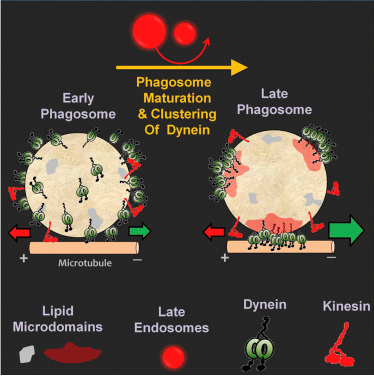Cell:胆固醇也好的一面:有助清除病原体
2016年2月6日/生物谷BIOON/--我们免疫系统的细胞通过将病原体包裹在一个被称作吞噬体(phagosome)的区室中来杀死它们。吞噬体经历程序性成熟,随后将病原体降解掉。与这种降解密切相关的是诸如动力蛋白(dynein)和驱动蛋白(kinesin)之类的纳米级“马达”蛋白主动运输细胞内的吞噬体。马达蛋白是很多类型生物运动的动力产生器。
由这些马达蛋白携带的吞噬体起初在细胞边缘附近来回移动,随后通过与其他区室融合而成熟。随着时间的推移,一种开关导致吞噬体以一种几乎单向的方式往细胞中心迁移。在那里,它们与酸性的溶酶体融合,从而能够降解病原体。
正如已在结核杆菌(Mycobacterium tuberculosis)和沙门氏菌--它们的存活和感染策略就是破坏这种开关---中观察到的那样,这种吞噬体迁移控制开关在病原体降解中发挥着重要作用。
如今,在一项新的研究中,来自印度孟买塔塔基础研究院的研究人员证实吞噬体的命运“开关”是由于被称作脂筏的胆固醇富含结构域(cholesterol-rich domain)在吞噬体膜上形成而产生的。论文通信作者RoopMallik教授说,“我们发现将病原体输送到溶酶体是通过很多纳米级马达动力蛋白的物理性簇集来实现的。”相关研究结果发表在2016年2月11日那期Cell期刊上,论文标题为“Dynein Clusters into Lipid Microdomains on Phagosomes to Drive Rapid Transport toward Lysosomes”。
动力蛋白在这些脂筏结构域中簇集,并且通过这样来做而能够以一个大的团队协同工作。这种胆固醇诱导的动力蛋白簇集组装将吞噬体迁往酸性溶酶体以便降解病原体。
重要的是,他们也证实来自寄生虫杜氏利什曼虫(Leishmania donovani)的一种脂质分子能够破坏动力蛋白的簇集,因而阻止吞噬体迁往溶酶体,其中杜氏利什曼虫导致内脏利什曼病(Visceral Leishmaniasis),即黑热病(Kala-azar),它是一种很多热带国家(包括印度在内)特有的致命性疾病。这可能是利什曼虫通过在我们的肝脏和肾脏免疫细胞内存活、增殖而能够扩散感染的机制。
Mallik教授说,“这一发现可能有助制定针对这些危险性感染的治疗策略。这些结果也与导致结核病和伤寒的病原体非常相关。我们的研究也证实这种很招人讨厌的胆固醇分子如何有助于清除感染。”(生物谷)

doi:10.1016/j.cell.2015.12.054
Dynein Clusters into Lipid Microdomains on Phagosomes to Drive Rapid Transport toward Lysosomes
Ashim Rai, Divya Pathak,Shreyasi Thakur, Shampa Singh, Alok Kumar Dubey,Roop Mallik
Diverse cellular processes are driven by motor proteins that are recruited to and generate force on lipid membranes. Surprisingly little is known about how membranes control the force from motors and how this may impact specific cellular functions. Here, we show that dynein motors physically cluster into microdomains on the membrane of a phagosome as it matures inside cells. Such geometrical reorganization allows many dyneins within a cluster to generate cooperative force on a single microtubule. This results in rapid directed transport of the phagosome toward microtubule minus ends, likely promoting phagolysosome fusion and pathogen degradation. We show that lipophosphoglycan, the major molecule implicated in immune evasion of Leishmania donovani, inhibits phagosome motion by disrupting the clustering and therefore the cooperative force generation of dynein. These findings appear relevant to several pathogens that prevent phagosome-lysosome fusion by targeting lipid microdomains on phagosomes.
 此主题相关图片如下:1.png
此主题相关图片如下:1.png